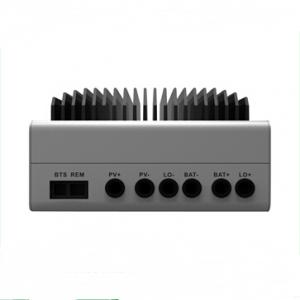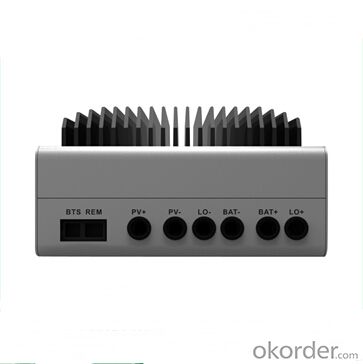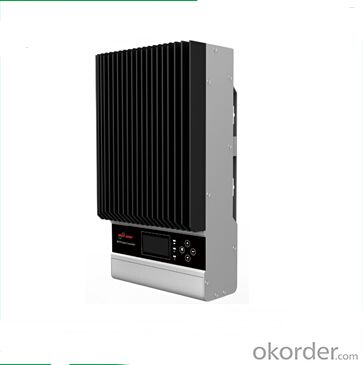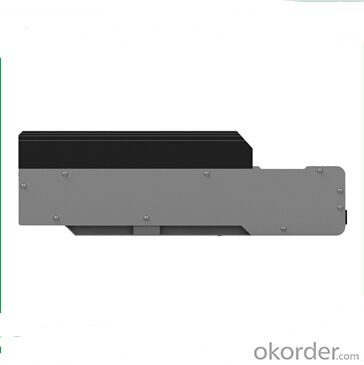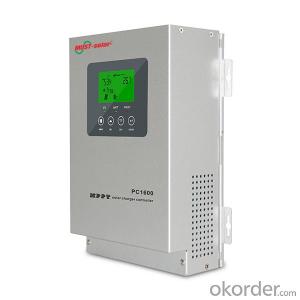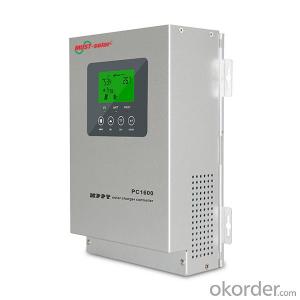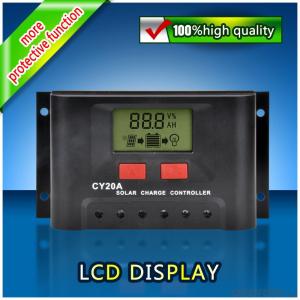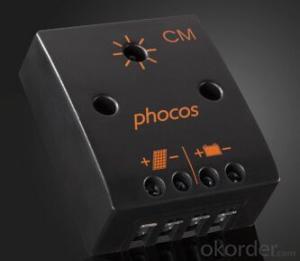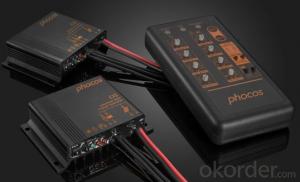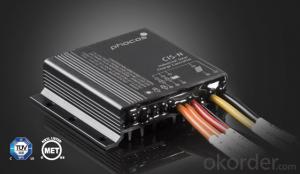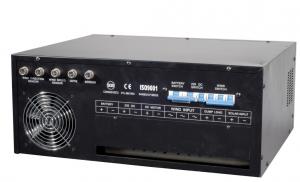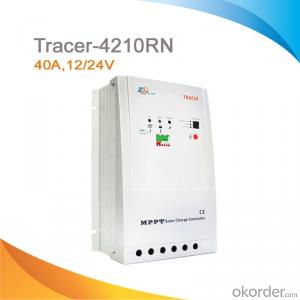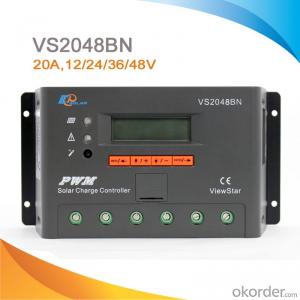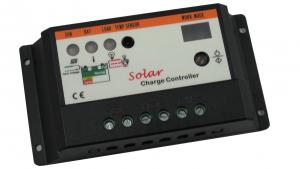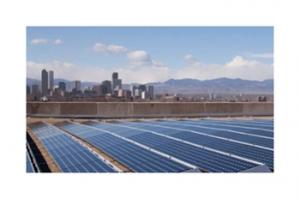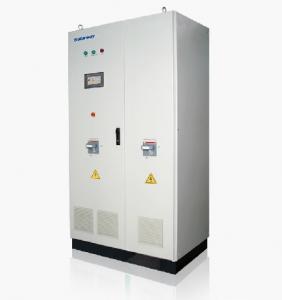Solar Geyser Thermal Controllers PC1600F Series Solar Charge Controller
- Loading Port:
- China Main Port
- Payment Terms:
- TT or LC
- Min Order Qty:
- -
- Supply Capability:
- 10000 unit/month
OKorder Service Pledge
OKorder Financial Service
You Might Also Like
Product Description:
Features:
45A/60A MPPT Solar charge controller
PV input :145V Max
12V/24V/36V/48V auto work
MPPT efficiency>99%,Peak conversion efficiency >98%
DSP processors technology ensure high speed and performance
Four-stages charging mode
Protection: PV array short circuit , PV reverse polarity , Battery reverse polarity , Over charging , Output short circuit
Model | PC1600-1 | PC1600-2 | |
Battery System Voltage | 12V/24V/36V/48 VDC (adjustable) | ||
Charge Input | |||
PV Open Circuit Voltage | Operational max = 145VDC temperature corrected VOC | ||
Max PV Input Power(12V) | 600W | 800W | |
Max PV Input Power(24V) | 1200W | 1600W | |
Max PV Input Power(36V) | 1800W | 2400W | |
Max PV Input Power(48V) | 2400W | 3200W | |
Battery Voltage | |||
Nominal Voltage | 12VDC/24VDC/36VDC/48VDC | ||
Absorption Voltage | 13.5VDC/27.0VDC/40.5VDC/54.0VDC | ||
Refloat Voltage | 13.7VDC/27.4 VDC/41.1VDC/54.8VDC | ||
Float Voltage | 14.3VDC/28.6 VDC/42.9VDC/57.2VDC | ||
Low Voltage Protection Point | 10.5VDC/21.0 VDC/31.5VDC/42.0VDC | ||
DC Output | |||
Output Voltage | 11.0~14.3VDC/22.0~28.6VDC/33.0~42.9VDC/44~57.2VDC | ||
Max Charging Current | 45A amps continuous @ 40°C ambient | 60 amps continuous @ 40°C ambient | |
Warning for low voltage | 11.5VDC/23.0 VDC/34.5VDC/46.0VDC | ||
Cutoff for low voltage | 10.5VDC/21.0 VDC/31.5VDC/42.0VDC | ||
Low voltage recovery | 11.5VDC/23.0VDC/34.5VDC/46.0VDC | ||
Display | |||
LED indication | Systematic operation, LV indication, LV protection, over charge protection, loads protection, short circuit protection | ||
LCD display | Charge voltage, charge current, voltage of battery, capacity of battery, output current | ||
Alarm | PV array short circuit protection, PV reverser polarity protection | ||
Battery reverse polarity protection, Over charging protection | |||
Output short circuit protection | |||
Low voltage protection for storage battery | |||
General specification | |||
Environmental Rating | Indoor | ||
Charge mode | MPPT, PWM, constant current—constant voltage, function of automatic protection for storage battery | ||
Radiating mode | Fan cooling | ||
Working mode | Four stage: Absorption CC, Absorption CV, Float CC, Float CV. | ||
Peak Conversion efficiency | 98% | ||
Environment | |||
Environmental temperature | -25°C ~55°C | ||
Ambient humidity | 0--90%,No condensation | ||
Altitude | ≤3000m | ||
Dimension | |||
W*H* D(mm)/G.W(kg) | 167.6*257.1*82.9mm/3kg | 390*365*364mm(5pcs/carton) | |
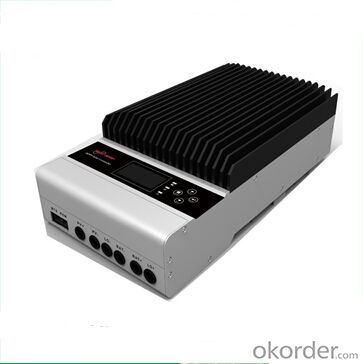
Warrenty
provides a 1~3 year limited warranty (“Warranty”) against defects in materials and workmanship for its Uninterruptible power supply, Power inverter/chargers, Solar charge controllers, Battery Products (“Product”).
The term of this Warranty begins on the Product(s) initial purchase date, or the date of receipt of the Product(s) by the end user, whichever is later. This must be indicated on the invoice, bill of sale, and/or warranty registration card submitted to MUST-Solar. This Warranty applies to the original MUST-Solar Product purchaser, and is transferable only if the Product remains installed in the original use location.
FAQ:
Q1. What is the voltage?
A1. Our 45/60A solar charge controller is 12/24/36/48V auto work.
Q2. What is the difference between MPPT&PWM?
A2. MPPT has higher efficiency, it can track the max power point and won't waste energy.
Q3. What is the efficiency of the MPPT controller?
A3. MPPT>99%, peak conversion efficiency>98%.
Q4. What is the waranty of product?
A4. 12 months.
Q5. What protection does your MPPT controller have?
A5. PV array short circuit, PV reverse polarity, Battery reverse polarity, Over charging, Output short circuit.
- Q: Can a solar controller be used with a solar-powered camping setup?
- Yes, a solar controller can be used with a solar-powered camping setup. A solar controller regulates the charging process of the battery and prevents overcharging, ensuring optimal performance and extending the battery's lifespan. Therefore, it is a crucial component for managing the power generated by the solar panels in a camping setup.
- Q: Can a solar controller be used with a solar-powered water pump?
- Yes, a solar controller can be used with a solar-powered water pump. A solar controller is a device that regulates the flow of electricity from the solar panels to the connected load, in this case, the water pump. It ensures that the pump receives the right amount of power and provides protection against overcharging or overloading. Therefore, using a solar controller with a solar-powered water pump is essential for optimizing performance and prolonging the lifespan of the system.
- Q: Can a solar controller be used with a solar-powered wireless communication system?
- A solar-powered wireless communication system can certainly utilize a solar controller. The role of a solar controller is to regulate the power output from solar panels, ensuring effective battery charging and safeguarding against overcharging. In the context of a solar-powered wireless communication system, the solar controller plays a vital role in power supply management for communication devices. By linking the solar panels to the solar controller, the charging process can be optimized through voltage and current adjustments tailored to the battery's requirements. This optimization enhances solar panel efficiency and guarantees proper battery charging. Furthermore, a solar controller offers essential safety features, such as preventing battery or communication system damage caused by overcharging. It also safeguards against reverse current flow, which may occur during low sunlight periods or at night when solar panels are inactive. In summary, a solar controller is an indispensable element for any solar-powered system, including wireless communication systems. It facilitates efficient power management, extends battery lifespan, and ensures reliable communication in remote or off-grid locations.
- Q: What are the different types of solar controllers available?
- The different types of solar controllers available include PWM (Pulse Width Modulation) controllers, MPPT (Maximum Power Point Tracking) controllers, and basic on/off controllers.
- Q: Can a solar controller be used with a generator as a backup power source?
- Yes, a solar controller can be used with a generator as a backup power source. The solar controller acts as a bridge between the solar panels and the battery bank, regulating the charging process. When a generator is used as a backup power source, the solar controller can still be used to regulate the charging of the batteries, ensuring efficient and safe power storage.
- Q: Can a solar controller be used with a solar battery charging system?
- Yes, a solar controller can be used with a solar battery charging system. A solar controller is an essential component in regulating the flow of electricity from the solar panels to the batteries. It helps prevent overcharging and damage to the batteries by controlling the voltage and current. Therefore, using a solar controller with a solar battery charging system is crucial for efficient and safe operation.
- Q: What is the maximum discharge efficiency of a solar controller?
- The maximum discharge efficiency of a solar controller refers to the percentage of energy that can be extracted from the battery bank by the controller. This efficiency can vary depending on the specific model and technology used, but generally, high-quality solar controllers can achieve discharge efficiencies of around 95% or higher.
- Q: Can a solar controller be used with solar-powered weather monitoring stations?
- Yes, a solar controller can be used with solar-powered weather monitoring stations. A solar controller helps regulate the charging and discharging of batteries in solar-powered systems, ensuring optimal performance and protection against overcharging or deep discharging. This is particularly important for weather monitoring stations that rely on solar power to operate efficiently and reliably. The solar controller helps maintain the battery's state of charge and ensures the station's continuous operation even during periods of limited sunlight.
- Q: What is the maximum load voltage a solar controller can handle?
- The maximum load voltage a solar controller can handle depends on the specific model and its specifications. It is recommended to consult the manufacturer's guidelines or the product manual to determine the maximum load voltage capacity of a particular solar controller.
- Q: Can a solar controller be used in a hybrid solar panel system?
- Yes, a solar controller can be used in a hybrid solar panel system. A solar controller, also known as a charge controller, is responsible for regulating the voltage and current from the solar panels to the batteries or grid. In a hybrid solar panel system, which combines both solar and other energy sources like wind or grid electricity, a solar controller is still necessary to manage the charge from the solar panels. It helps ensure that the batteries are properly charged and protected from overcharging or excessive discharging. Additionally, a solar controller can also monitor and optimize the energy flow between the different energy sources in a hybrid system, maximizing the efficiency and utilization of the solar power generated.
Send your message to us
Solar Geyser Thermal Controllers PC1600F Series Solar Charge Controller
- Loading Port:
- China Main Port
- Payment Terms:
- TT or LC
- Min Order Qty:
- -
- Supply Capability:
- 10000 unit/month
OKorder Service Pledge
OKorder Financial Service
Similar products
Hot products
Hot Searches
Related keywords
